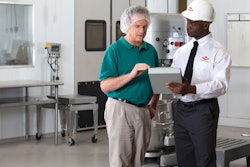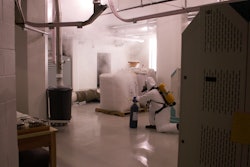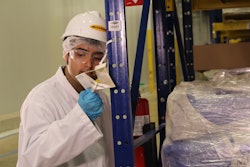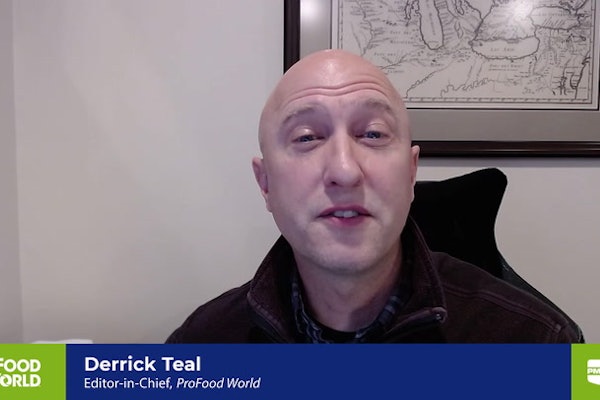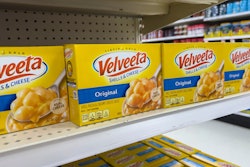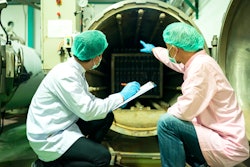Though many food distributers are aware of food safety protocol, their employees may not be as familiar. Judi Lazaro, senior category director of food safety at AIB International presented the first part of AIB International’s five-part Food Protection for Warehouses and Distribution Centers Webinar Series.
Current Good Manufacturing Practices apply not only to manufacturers but also to distribution and warehousing. To help companies meet the demands of these practices, AIB International sends inspectors to identify a building’s food safety issues and help eliminate them. AIB inspectors follow the “may clause” when doing their inspections. For example, an inspector only needs to see rat droppings to decide a building is unsafe, as that is a good indicator that there “may” then be rodents in the facility. This clause provides a further layer of caution to ensure a warehouse or distribution center meets top standards.
Lazaro provided a breakdown of which main food safety issues are the most overlooked or commonly taken care of improperly in distribution and warehousing, as well as suggestions to solve the issues.
Pest control
Pests are one of the top five global issues in distribution and warehousing, and pest control has been one of the top misses for facilities within the last five years, according to Lazaro. Birds and rats are often reported as pests, but Lazaro emphasized that any animal in the vicinity is considered a pest, including cats–which usually go unreported and are even welcomed and fed by employees. Though this does not mean that the only way to remove such animals is by euthanizing them.
On the topic of rats, these rodents use their long whiskers to help them travel. Previously, a rule held that product must be kept 18in away from walls. Though this has been removed from AIB’s rules, keeping product some distance away from the wall is beneficial. If a rat’s whiskers don’t touch the product near the walls, then it will continue to travel along the wall where rodent control devices have been placed. The distance from the wall also allows for easier cleaning.
Pest control device placement is often misunderstood; these should be custom-positioned based on the facility assessment. If no assessment is available, a facility should place the devices at 20-40 ft intervals. Another common misconception is that insect light traps are required in facilities; but if they are installed, there are rules that apply. These rules include the placement of the traps in regard to food and not letting them be visible from the outside, which would only attract more insects.
The kind of and number of pests that get into a facility can be affected by climate. A company must consider location, food, and water stored within the facility to determine if and what kind of pest control is needed.
The pest citing log should be kept in an easily accessible location for operators, who are more likely to spot pests. Lazaro suggested encouraging employees to fill out the log through the use of incentives, such as free lunch coupons, scratch off lottery ticket, etc.
Walls, ceilings, floors, and doors
The floor-wall junction is the area that AIB instructors find needs the most help. The junction is easily overlooked as visitors to a facility walk the aisles and thus the floor-wall junction remains out of view.
Ceilings and overheads can have leaking problems, which are commonly patched up with tarps, called roof diapers. However, this temporary solution does not eliminate the issue and, like diapers do, will add to the master cleaning schedule. Placing work orders and outsourcing repairs are the most effective solution.
Holes, cracks, and crevices in the floor can hold dirt, and pest and microbial harborage. This includes sealing expansion joints due to the possibility of getting food in them. (This excludes canned goods facilities.) Before making the investment, managers can talk to consultants such as AIB, send pictures, and get help in making the decision to seal or not. Also commonly ignored are floor drains in produce areas. These often grow mold and house cockroaches. Floor drain cleanings need to be put on the master cleaning schedule.
Be sure doors are closed and sealed to minimize dust, debris, and pests entering the facility. If a door is not well fitted into the wall, encourage employees to put in work orders. Employees must also be trained to never leave doors open, despite the heat. The same principles apply to windows, pipes, and other objects that pass through the walls.
Food and non-food products
As product is consistently moving in and out of a warehouse, it’s the non-product zone–with the forklifts, scissor lifts, and large ceiling fans–that gathers the most dust. This equipment should also be on the master cleaning schedule. AIB International offers proactive, general cleaning schedules on its website.
The outside trash dumpster is another part of the non-product zone that is often overlooked. Lazaro suggests working closely with trash haulers to make sure they clean debris that spills.
Storing food and non-food products next to each other can effect food products through smell. Lazaro gave the example of flour and tires stored next to each other. Complaints came back to the warehouse due to the odor from the rubber tires absorbing into the flour. Only store food and non-food products next to each other if you know the possible risks.
Worker training
Referring back to the “may clause,” workers should strictly follow policies against eating, drinking, and smoking inside the facility. Evidence of issues is typically found behind storage racks at the floor-wall junction.
Workers should also be trained to neither sit nor step on product boxes–as obvious as this might seem, employees aren’t always respecting this rule during inspections.
Always label your cleaning products and chemicals
Workers have been known to bring in their own cleaning materials in to take care of pest problems. This must be discouraged as staff is not properly trained for this function, and chemicals must be approved. Document the list of the cleaning supplies for your chemical control inventory–inspectors will also ask for this list.
PACK EXPO Las Vegas and Healthcare Packaging EXPO (Sept. 27-29, Las Vegas Convention Center) will reunite the packaging and processing community, offering new products, technologies and solutions, while implementing up-to-date protocols for a safe and successful in-person event. Attendee registration is now open.


